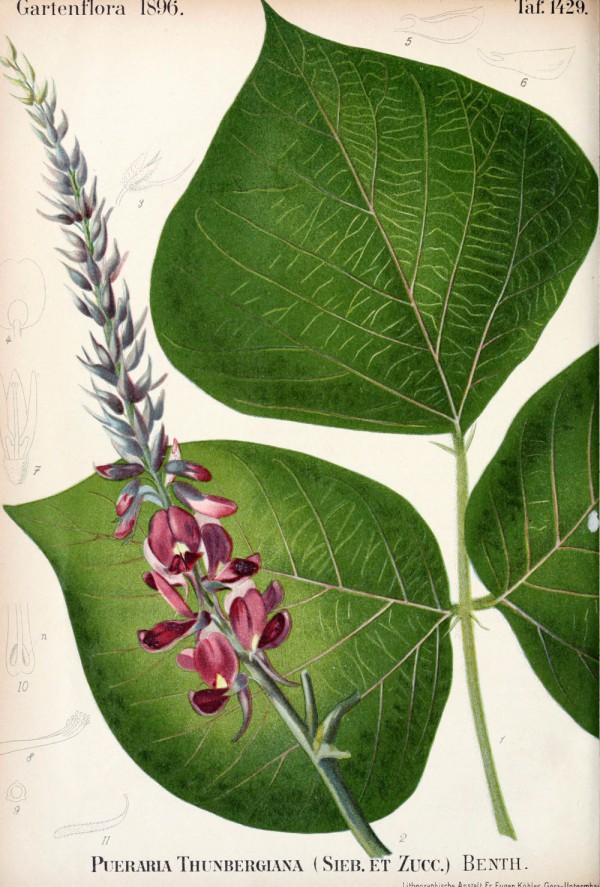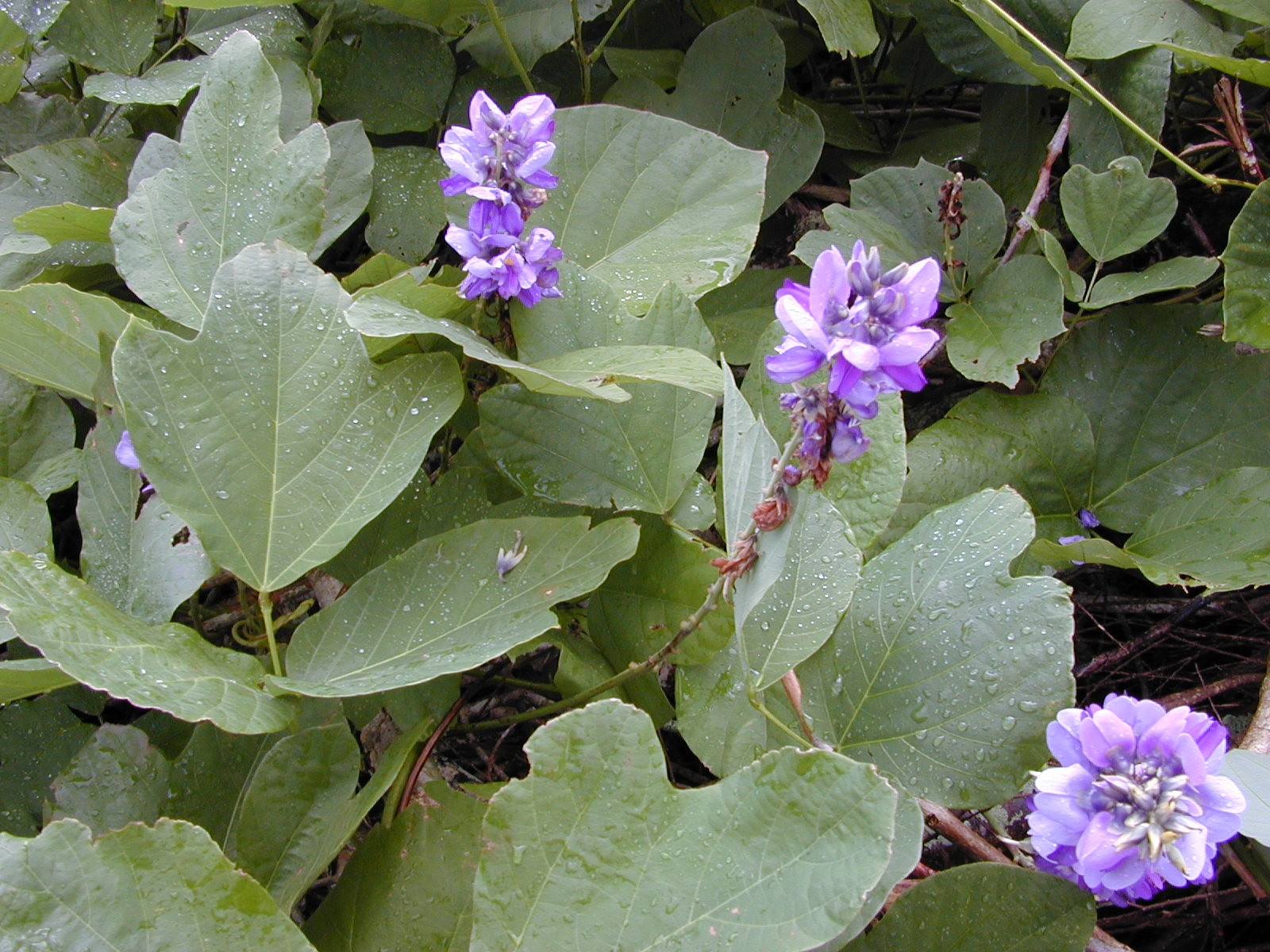Pueraria montana (Lour.) Merr. - syn.Pueraria lobata (Willd.) Ohwi - Fabaceae - 葛 ge (chin.), kudzu (vine), Kudzubohne, Kopoubohne
Climber, commonly known as kudzu vine, woody at base, hirsute with yellowish hairs in all parts, native to Asia (from India to Japan) and southwestern Pacific Islands, naturalized and cultivated elsewhere; leaves tripinnate, leaflets broad ovate, entire; long racemes (15-30cm) of fragrant purple flowers.
Pueraria montana var.montana = Dolichos montanus Loureiro; 葛(原变种) ge (yuan bian zhong)
Pueraria montana var. lobata (Willd.) Maesen = Dolichos lobatus Willd.; Pueraria lobata Ohwi; Pueraria thunbergiana (Siebold & Zucc.) Benth.; 葛麻姆 ge ma mu; used medicinally and as edible tubers, a cover crop, and fodder.
Pueraria montana var. thomsonii (Bentham) M.R.Almeida = Pueraria thomsonii Benth.; 粉葛 fen ge; used as a vegetable and for extracting starch
http://www.efloras.org/florataxon.aspx?flora_id=2&taxon_id=200012296
The fresh young shoots are very nutritious and taste like a mixture of beans and peas… The starchy tuberous roots of var.lobata are eaten cooked. The tubers may be up to 1.8m long and 35kg heavy. They contain up to 10% extractable starch, used for breading, thicken soups or pasta. http://de.wikipedia.org/wiki/Kudzu_%28Pflanze%29
Kudzu leaves contained 0.012% of an essential oil (SD) with 2-methoxy-4-vinylphenol, 2-methoxy-5-vinylphenol, damascenone and phytol.
[On the constituents of an essential oil of kudzu., Shibata, S., Katsuyama, A., Noguchi, M., Agricultural and Biological Chemistry, Vol.42(1), 1978, 195-197]
http://www.tandfonline.com/doi/pdf/10.1080/00021369.1978.10862952
„The roots of Pueraria thomsonii and Pueraria lobata are officially recorded in Chinese Pharmacopoeia under the same name Radix Puerariae. However, the aqueous root extract of Pueraria lobata showed more potent antioxidant activity than that of Pueraria thomsonii. A qualitative HPLC method was developed to compare the chemical profiles of Pueraria thomsonii and Pueraria lobata, which revealed four major common peaks, daidzein (1), daidzin (2), puerarin (3) and 5-hydroxypuerarin (4) and two major different peaks, 3-hydroxypuerarin (5) and 3′-methoxypuerarin (6) in their chromatograms. Semi-quantitative analysis showed that the contents of 1–3 in Pueraria lobata are about three, three, and five times higher than those of Pueraria thomsonii, respectively. The higher contents of isoflavonoids in Pueraria lobata were inferred to be responsible for its more potent antioxidant activity as compared with that of Pueraria thomsonii. The HPLC method developed in this study and chemical markers 1–6 can be used for the rapid identification and evaluation of Radix Puerariae herbs and their aqueous supplements, and the results of this investigation support the use of Pueraria lobata and Pueraria thomsonii in the clinic application and as dietary supplement, respectively.“
[A comparative study on aqueous root extracts of Pueraria thomsonii and Pueraria lobata by antioxidant assay and HPLC fingerprint analysis., Jiang, R.W., Lau, K.M., Lam, H.M., Yam, W.S., Leung, L.K., Choi, K.L., Fung, K.P., Journal of ethnopharmacology, Vol.96(1), 2005, 133-138]
„The roots of Pueraria lobata (Wild.) Ohwi and Pueraria thomsonii Benth have been officially recorded in all editions of Chinese Pharmacopoeia under the same monograph ‘Gegen’ (Radix Puerariae, RP). However, in its 2005 edition, the two species were separated into both individual monographs, namely ‘Gegen’ (Radix Puerariae Lobatae, RPL) and ‘Fenge’ (Radix Puerariae Thomsonii, RPT), respectively, due to their obvious content discrepancy of puerarin, the major active constituent… Obvious difference in ingredient content and HPTLC patterns of the two species questioned their bio-equivalence and explained that recording both species separately in the current edition of Chinese Pharmacopoeia (2005 edition) is reasonable due to not only the content of major constituent, puerarin, but also the peak-to-peak distribution in the fingerprint and integration value of the total components.“
[High-performance thin-layer chromatographic fingerprints of isoflavonoids for distinguishing between Radix Puerariae Lobate and Radix Puerariae Thomsonii., Chen, S.B., Liu, H.P., Tian, R.T., Yang, D.J., Chen, S.L., Xu, H.X., Xie, P.S., Journal of Chromatography A, Vol.1121(1), 2006, 114-119]
„Kudzu root (Gegen in Chinese) is the dried root of Pueraria lobata (Willd.) Ohwi, a semi-woody, perennial and leguminous vine native to South East Asia. It is often used interchangeably in traditional Chinese medicine with thomson kudzu root (Fengen in Chinese), the dried root of P. thomsonii, although the Chinese Pharmacopoeia has separated them into two monographs since the 2005 edition. For more than 2000 years, kudzu root has been used as a herbal medicine for the treatment of fever, acute dysentery, diarrhoea, diabetes and cardiovascular diseases. Both English and Chinese literatures on the traditional applications, phytochemistry, pharmacological activities, toxicology, quality control and potential interactions with conventional drugs of both species have been included in the present review. Over seventy phytochemicals have been identified in kudzu root, with isoflavonoids and triterpenoids as the major constituents. Isoflavonoids, in particular puerarin, have been used in most of the pharmacological studies. Animal and cellular studies have provided support for the traditional uses of kudzu root on cardiovascular, cerebrovascular and endocrine systems, including diabetes and its complications. Further studies to define the active phytochemical compositions, quality standards and clinical efficacy are warranted. Strong interdisciplinary collaboration to bridge the gap between traditional medicine and modern biomedical medicine is therefore needed for the development of kudzu root as an effective medicine for the management of diabetes and cardiovascular diseases.“
[Kudzu root: traditional uses and potential medicinal benefits in diabetes and cardiovascular diseases., Wong, K.H., Li, G.Q., Li, K.M., Razmovski-Naumovski, V., Chan, K., Journal of Ethnopharmacology, Vol.134(3), 2011, 584-607]

Pueraria montana (Lour.) Merr. [as Pueraria thunbergiana (Siebold & Zucc.) Benth.]
Regel, E.A. von, Gartenflora (1852-1938) vol. 45 (1896) t. 1429
http://plantgenera.org/species.php?id_species=854010

Pueraria montana var. lobata (leaves and flowers); Maui, Honomanu Hana Hwy (2002)
CC BY-SA 3.0, Author: Forest & Kim Starr Wikimedia Commons